In this special Blog Takeover, Drew Friedrich with the Grind Golf blog shares the highs and lows of “Chasing 8” and how Roundabout was the key to improving his approach to the green.
The Beginning
I had a goal, but no path to get there…then I found Roundabout.
For as long as I can remember I’ve been an athlete and a pretty good one. I’ve always been a big guy and I could always generate a lot of power, and as I grew into my early teen years, baseball came naturally to me. I could hit the ball harder and farther than anybody else I played with, and I loved the feeling of really catching a ball in the middle of the barrel and watching it fly.
I got that same sensation the very first time I ever hit a golf ball on the screws. We were at a driving range a year or so after I’d graduated college and was done playing ball, and I bought my very first set of clubs. Nike everything from putter through driver…the old Nike Sasquatch square driver that sounded like a metal bat when you hit it. It was uglier than sin, and louder than anything else on the range, but when I hit it out of the middle, the ball seemed to stay in the air forever. I flew one to the back of the driving range, and suddenly I’d been bit by the bug.
As a baseball player who could hit a ball moving vertically and horizontally at 85-95 miles per hour, I thought hitting a stationary ball with a giant club head would be no problem. As any golfer reading this knows, however, that’s just not how it works. I struggled with a giant slice for many years, but over time with a few brief lessons, and what seems like thousands of hours spent watching Youtubers like Rick Shiels, Peter Finch, the boys from Me and My Golf, and the Bryan Brothers, I’d whittled my way down around a 15 handicap. I was still prone to the big miss with the driver, but I was at least respectable and felt like I could go play and compete with other golfers without embarrassing myself.
When I moved back to Virginia, I didn’t know many people, and since I’d started golfing while I was in Tennessee, I didn’t know a single person who golfed. I just knew I didn’t want to play alone all the time. I liked competing and comparing my game with others. I hadn’t been able to really compete since college, and I was itching for the chance to match up and try to beat someone.
My father never really golfed, but I grew up with an extended family that was crazy about golf. My uncle and cousin were scratch golfers and my new brother-in-law was a 7, so I knew if I was going to play without embarrassing myself, I needed to improve, and fast. We’d get together and they’d shoot between 72 and 80, while I was posting numbers in the high 90s and low 100s. That lit a fire inside me to improve. I would go to the range and hit ball after ball and think I found something, then head to the course, and shoot 88 or 91 every time out. I felt like I was improving, but my scores didn’t reflect that improvement. Was I actually a better golfer?
The Challenge!
One of my best golfing buddies and I set out in 2021 to ‘Chase 8,’ and attempt to get down to 8 handicaps. We were both 12 handicaps in January and we felt like getting to 8 handicaps was a reasonable, but aggressive goal that would give us each something to strive for, while scratching that competitive itch.
I was excited to get going. I bought us matching ball markers with ‘Chasing 8’ inscribed. We were determined to improve, and I spent hours at the range trying to find the secret in the dirt that would unlock my potential and finally get me down to a single-digit handicap. It was clear I was hungry for the chase, but as January came and went, I found myself with a higher handicap (12.3) than I’d had at the outset. This was not going to be as easy as I’d hoped.
87…93….87….96….this was NOT the game of an 8 handicap. I was practicing so much, but why wasn’t I scoring better?
If you’d have asked me at the time what the problem with my game was, I’d have told you 100% it was my driver costing me strokes. I was losing 2-3 penalty strokes per round and it was DEFINITELY the thing that was holding my game back. Except it wasn’t! In fact, as you’ll see below, driver had the LEAST impact on my scoring of any part of my game!
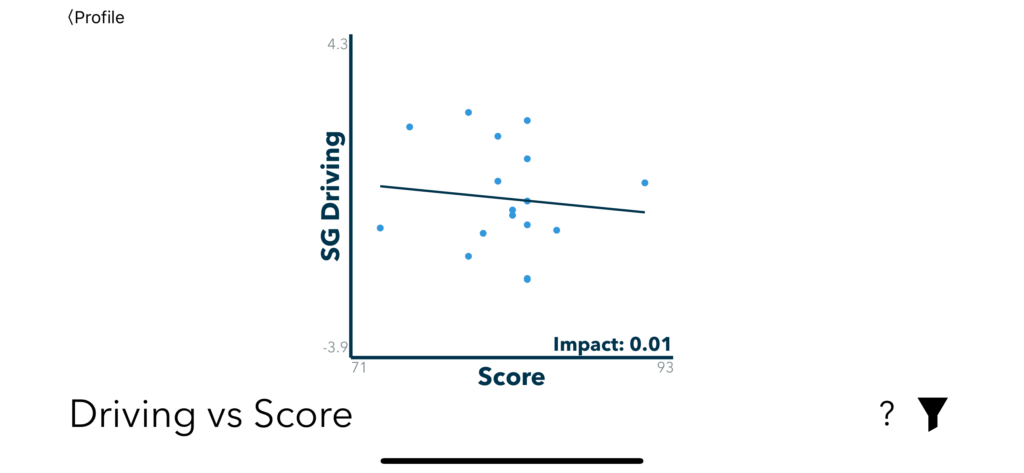
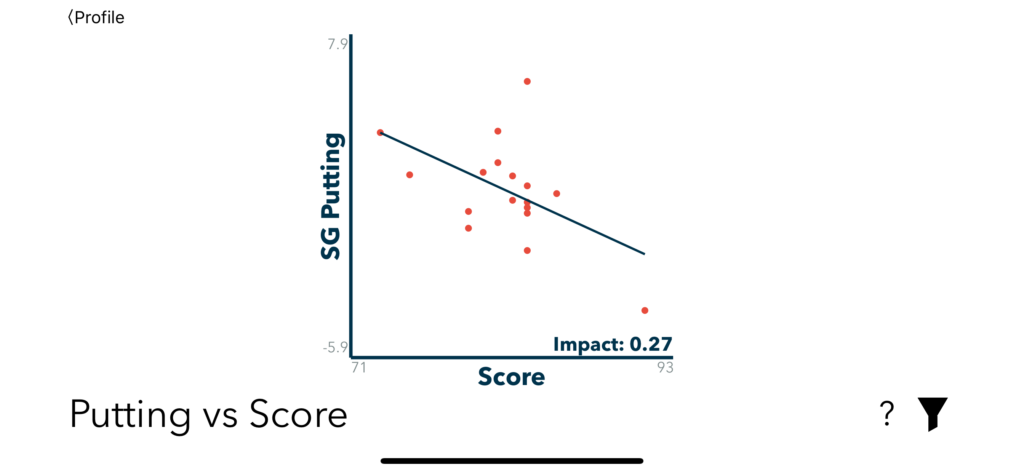
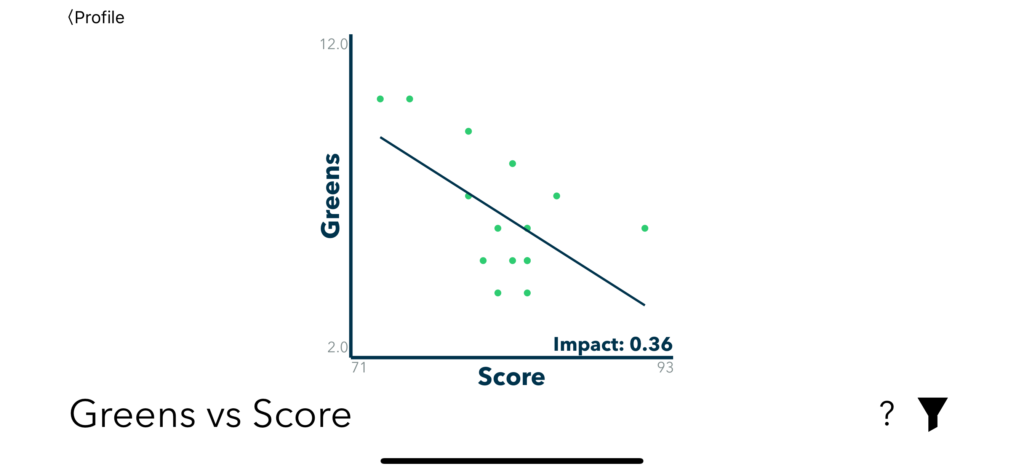
The Turn
In March of this year, my family and I moved into a new home in a golf course community in our city. We don’t live on the course, but at the end of a through street that bisects the 6th and 7th holes. I can walk out with a shag bag and chip and pitch and putt any evening I want, and I can rip Driver on the driveable par 4 7th, or move up a tee box and hit 3w, or driving iron, or basically any shot I want. That was big, but practicing wasn’t ever the problem. I’d always been able to hit a bunch of balls, and it didn’t seem to translate to the course. I needed to score better during my rounds, and I had to figure out exactly where the improvement needed to come from. It couldn’t be just the driver keeping me from lower scores.
I tried Arccos at first, but I found the experience to be clunky and inaccurate. I didn’t love putting the sensors in the end of my clubs, and I found myself thinking more about whether or not the sensors had picked up my shots correctly than about the actual shots I was about to hit. I quickly sold the sensors and moved on, frustrated.
Then I stumbled across something that looked really interesting. The Roundabout app. I’d spent hours listening to podcasts and reading about strokes gained and the importance of having clear information about where golfers gain and lose strokes on the course, but I never knew how to make that sort of data work for me. When I stumbled across the Roundabout app and saw how it would track my shots just like Arccos did, but in an automatic, hands-free approach, and spit out useful strokes gained data, I knew I needed to give it a shot.
As I headed out to give Roundabout a try, I immediately loved the user interface on the phone app. It took me just seconds to set up the round and get started. I decided to test their ‘breadcrumb’ technology, and put the phone in my back pocket, deciding I’d only look at it between holes. I didn’t want to have to be messing with my phone between shots and holding anybody up on the course.
I hit driver up the right, gap wedge to about 25 feet, and 2-putted for par. as I got in the cart and entered my score in the app, it was perfectly precise in identifying where I’d hit my shots from. I selected the club for each, and was on my way. Rinse and repeat 17 more times, and by the end of the round, I had a clear picture of every shot I’d hit on the course, as well as a detailed summary of my round.
Turns out it wasn’t my driver holding me back. Yea it might have cost me a stroke or two per round, but it was poor approach play, double chips inside of 50 yards, and poor putting that really kept me in the high 80s. Eye-opening to say the least!
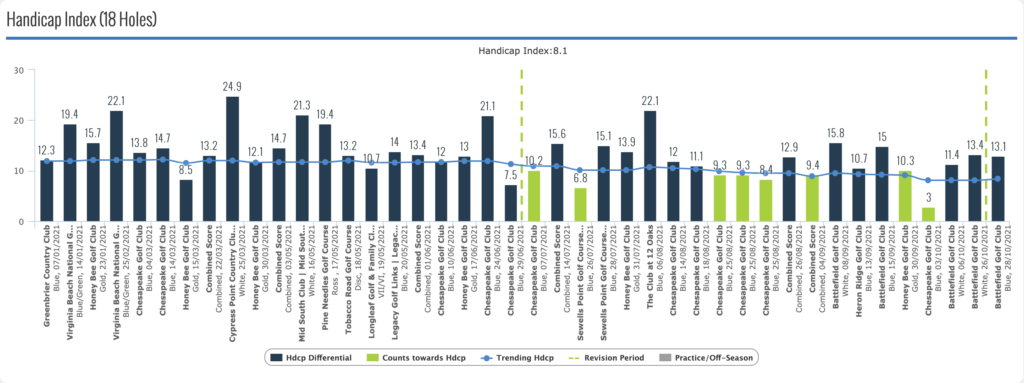
Differentials since 1-1-2021. Notice a significant difference following the 22.1 (99) at 12 Oaks Golf Club. That’s right around the time I began using Roundabout to track and improve my scoring.
The Drop
As I logged more rounds in Roundabout, I began to notice that while I was still making a couple of driver mistakes per round, the real keys to my scoring were approach play and putting. The driver was still incredibly important, but as a high swing speed player, distance was going to be there. If I could eliminate penalties and leave myself looks at the green, I drove it long enough and straight enough to get to an 8 handicap. I had to hit more greens and give myself more opportunities to avoid double bogeys and make birdies and pars.
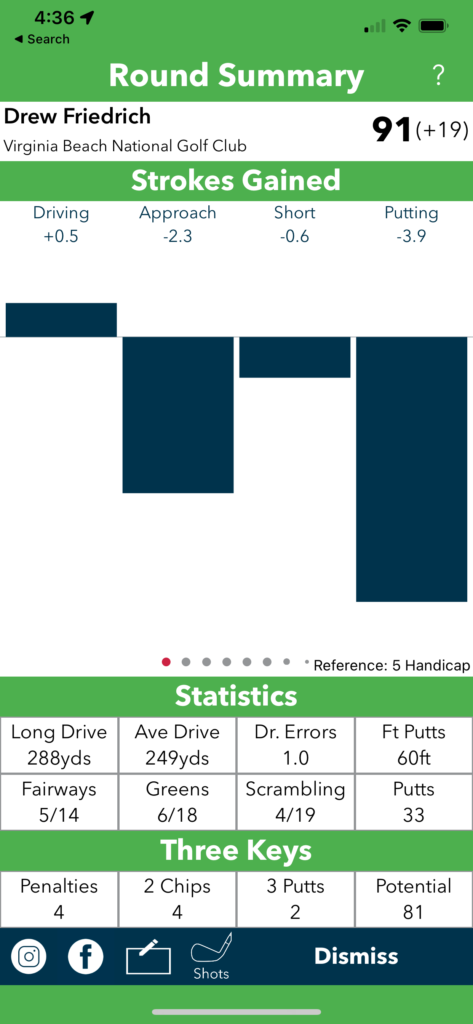
My First Round Summary in Roundabout. Notice 4 penalty strokes, but +.5 SG driving. I didn’t understand at the time, but it was what I did AFTER those poor drives that made all the difference in the world!
As my focus shifted away from driver and toward my iron play and wedges, I began to notice upticks in my Greens in Regulation and scrambling scores. As those numbers improved, my scores began to drop. I was following the game plan V1 set out for me, and it was producing immediate results. Stokes gained let me know that sending it with driver whenever possible gave me the best chance to hit a more accurate approach shot, and more accurate approach shots led to better scores. It’s not rocket science, but without the data, I’d have still thought my bad play was due to poor driving. In reality, I drive it well enough to score. I was just not hitting good second shots, or even after taking a penalty stroke with the driver, I was missing greens, hitting poor chips and turning pars and bogeys into doubles and triples.
I’m thrilled to say that my chase for 8 is complete. After using V1 for 3 months and working hard to implement the things the app was showing me I needed to do to improve, I went from a 12.3 in January to an 8.1 by the beginning of October.
The next goal for me is a 5 handicap. I now compare all of my strokes gained data against a 5 handicap in the app so I can develop a new blueprint to get my scores down where they need to be.
The App
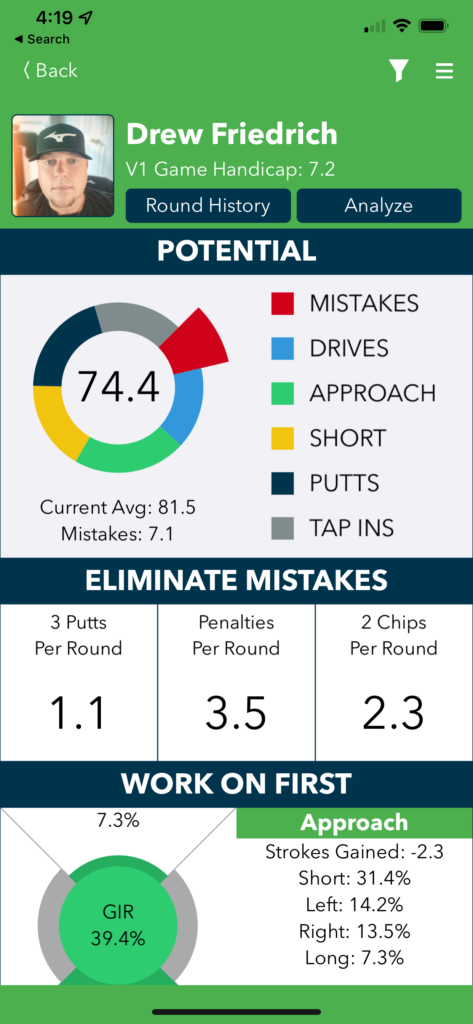
As you can see, approach still needs work, as I’m losing 2.3 strokes per round to a 5 handicap, but it’s improving. Driving is still gaining me .1 stroke per round despite me still struggling with a few penalty strokes each time out, but I hit enough good, long drives that in the end, driver is a positive. I’d actually hurt myself by laying back with 3 wood, which I used to do religiously.
The “POTENTIAL” number that Roundabout spits out is like the dangling carrot for me. When I see that number, 74, and realize I’m averaging 81, and it’s largely due to mistakes, it fires me up to go play more and improve the quality and consistency of my game. V1 has me as a 7.2 handicap only because I haven’t been playing long enough to have all my GHIN rounds in there, but I have every intention of getting to 7.2 and lower with the help of Roundabout. It has been a revelation to me and I recommend it to anybody I play with.
The app experience couldn’t be more hands-off. You can edit your shots after each shot, between holes, or not touch the phone until you’ve played all 18. I tend to fall somewhere between every hole and not touching it at all. The great thing is, it doesn’t interfere with your game, but provides you with tour-quality data that you can use to improve.
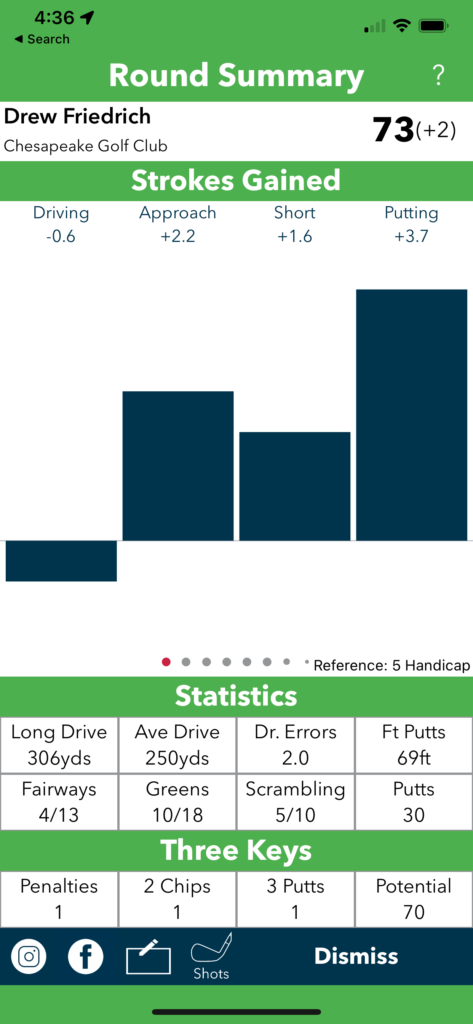
The Round Summary from my best round ever, a 73: Strokes gained EVERYWHERE, but the largest gains were in the SG Approach, Shortgame & Putting categories. I technically actually drove it worse during this round than I did in the 91 shown above. That never would have made sense to me before, but I hit 10 Greens in Regulation, scrambled my tail off, and putted a little better than average.
The data doesn’t lie. I don’t need to improve my driver. It’s incredibly important and is a weapon, but it’s not the thing holding me back. I’m thrilled to have the confidence to know that when I go to the range or take a lesson, it’s my iron and wedge ball-striking that’s going to get me to my next milestone. Putter is important too, but I’ve found that all golfers have good and bad days putting. You can improve it, but it has a lot to do with course conditions, pin placements, etc. If I can improve the quality of the strike with my irons and wedges, my whole game improves.
Bottom line: If you want to shoot lower scores, understand where you’re losing strokes, and beat your buddies more consistently, Roundabout is absolutely the key. Don’t assume you know how to fix your game. I did that for too many years, and I was consistently a 12-15 handicap for far too long. It’s not coincidence that as soon as I was able to clearly see the path to improvement and shift my mindset to fit that path, my scores began to plummet. I shot my best round ever, 73, with 10 Greens in regulation and 26 putts, a few weeks ago. I had to hit the shots, yes, but Roundabout helped me see the road to 8, and if I continue to follow the data, I’ll be knocking on 5’s door next!
Written By: Drew Friedrich, Grind Golf
Check out all of Drew’s work covering his journey here and his twitter profile can be found here

